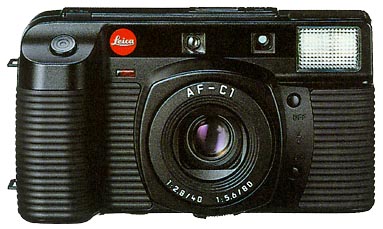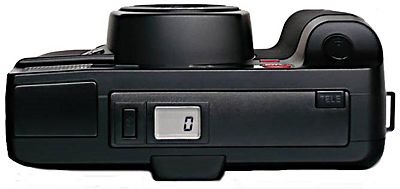AF-C1
Production era - 1989-1991 LeicaWiki.de
Order nos. - 18001, 18010-DB
Type - Compact film point-and-shoot view-finder camera.
Lens - 40 mm f/2.8 and 80 mm f/5.6
Focus range - 0.7 m / 2.3 ft < infinity
Autofocus system - Active multi-beam infrared autofocus with focus memory and coupled exposure memory.
Exposure system - Automatic exposure system, center-weighted integral metering with automatic flash activation in low light or extreme contrast.
Memory - Focus is locked and metered value saved with light pressure on shutter release button.
Exposure override - none.
Metering range 8 cd/m2 > 123,000 cd/m2. At ISO 100 Ev6 (1/5 s and f/3.5) > Ev16 (1/250 s and f/14) Autoflash with exposure > Ev10.
Shutter speed range - 1/8 s > 1/400 s.
Film speed setting - Film speed automatically set for DX-coded films from ISO 50 to ISO 3200. With film without DX-coding the camera is automatically set to ISO 100.
Automatic flash - In poor lighting conditions the flash is activated automatically. Manual ON/OFF capability at any time. Shutter release blocked until flash is ready. Flash interval with new battery about 1.8 s.
Viewfinder - autofocus measuring field and markings for close range. Enlargement 0.5x for 40 mm lens, 1.0x for 80 mm lens equivalent to 85% of field at 3 m.
LED symbols - self-timer, low battery, film loaded, frame counter.
Film transport - Automatic threading and advance to first frame. Automatic rewind after last exposure. Midroll rewind possible.
Data panel - Liquid Crystal Display (LCD) indicates symbols for self-timer, battery status, frame count, flash activation.
Self-timer 10 sec. countdown; indicated by diode (LCD) on front of camera.
Power supply - 6V lithium battery (2CR5).
Body - Black plastic. Side attachment for carrying strap or wrist strap. Tripod thread A1/4 DIN 403 (1/4").
Weight - 345 g without batteries.
Dimensions (W x H x D) - 140 x 65 x 60 mm (40 mm focal length).
Manufacturer's User's Manual courtesy of Mike Butkus.

